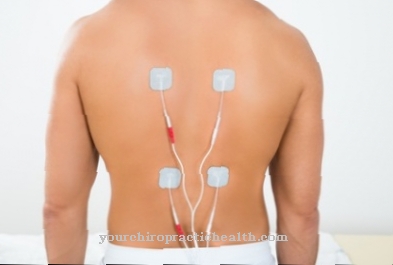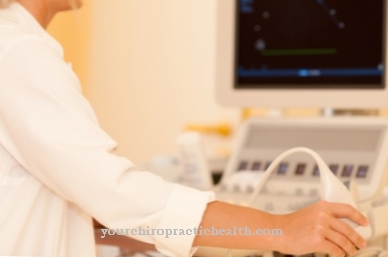At a Triple test is a risk assessment of whether a fetus has a chromosomal abnormality or a neural tube malformation. The test does not provide a reliable diagnosis, but is carried out to assess whether an amniotic fluid test should be carried out if necessary.
What is the triple test?

The triple test is a blood test for prenatal diagnostic aid in patients with a high-risk pregnancy. It is used to assess whether there is an increased risk of having a child with trisomy 21, trisomy 18 (chromosomal disorder) or spina bifida (open back).
The triple test determines the concentration of alpha-fetoprotein (AFP), the hormone estriol and that of the hormone human chorionic gonadotropin (hCG) in the blood of the expectant mother. The three values of the concentration in relation to the age of the pregnant woman and the health history allow a risk assessment. The resulting result is decisive for possible further examinations, such as an amniocentesis (amniotic fluid examination).
The test is carried out between the 14th and 18th week of pregnancy and a test result is available after a few days. Long-term studies have shown that the risk assessment and its prognosis are often incorrect, which is why the triple test is now considered unreliable and is only rarely carried out.
Function, effect & goals
In order to carry out a risk assessment using a triple test, blood must be drawn from the pregnant woman. The blood is then sent to a laboratory to determine and assess the levels of a certain protein and two hormones.
The protein to be determined is the so-called alpha-fetoprotein. Within the fetus, the protein is produced, among other things, in the liver and excreted in the amniotic fluid. If the skin of the fetus is not closed, as is the case with spina bifida, for example, increased alpha-fetoproteins are released into the amniotic fluid and the concentration is increased accordingly. However, if the concentration of alpha-fetoprotein is below the norm, this can be an indication of a chromosomal abnormality. A hormone is produced by the adrenal gland and liver of the fetus, which is converted to the hormone estriol within the placenta.
The hormone can also be detected in the pregnant woman's blood. In the course of pregnancy the concentration in the blood increases. If the concentration of estriol is below normal values, this can also be a sign of a chromosomal abnormality and the risk that the fetus will suffer from trisomy 21 is increased. Third, the triple test assesses the hormone human chorionic gonadotropin, also known under the abbreviation hCG. The hCG hormone is released just a few days after fertilization.
In a pregnancy test, the urine is therefore also tested for the hCG hormone and a possible pregnancy can be detected or excluded at an early stage. If the concentration in the triple test of human chorionic gonadotropin is increased, this can be an indication of trisomy 21 (Down's syndrome). If the value is below the norm, this can be a sign of trisomy 18 (Edwards syndrome).
The result, which results from the concentration in the blood, is not evaluated in detail in the triple test. For the result, the individual age and previous illnesses of the expectant mother, as well as weight gain during pregnancy, duration and the previous course of the pregnancy are included in the overall result. Furthermore, it is important for the risk assessment whether children with a genetic defect or spina bifida have already been born by the woman or whether such diseases have a family history.
Studies and the long-term implementation of a triple test have shown that the accuracy can only be classified as “medium”. The testing will detect early about 70 out of 100 fetuses with a chromosomal abnormality or open back. However, around 7 in 100 are mistakenly mistaken for an unborn baby with trisomy 21 or trisomy 18. Basically, the triple test achieves higher accuracy in middle-aged women than in young women.
Many parents-to-be are unsettled by the result and may make wrong decisions. It should always be noted that the triple test does not provide a reliable diagnosis, but only serves to assess the risk. More tests are needed to make a diagnosis. An aminocentesis (amniocentesis), for example, provides clarity.
Risks, side effects & dangers
Taking blood for the triple test poses no risk for the mother or her unborn child. The actual risk is based on the probability theory that the triple test causes. The test does not make a diagnosis and this can lead to wrong decisions by the parents-to-be.
There are also many disruptive factors that can influence and falsify the result. In the case of multiple pregnancies, the concentration of hormones and protein is generally increased. Pregnant women who smoke or eat a vegetarian or vegan diet also have an increased hCG value, despite a healthy fetus.In addition, an incorrect calculation of the length of pregnancy, excess weight and diabetes of the expectant mother can affect the result. Disturbed growth of the fetus, dysfunction of the placenta and kidney dysfunction in the pregnant woman can also cause increased concentration values.
The triple test can therefore show deviating values even though the unborn child is healthy. If there is an increased risk from the treating specialist and the parents-to-be want a confirmed diagnosis, an aminocentesis should be performed. The triple test can be used in advance to help decide whether an aminocentesis with the increased risks should be carried out.












.jpg)



.jpg)










.jpg)
